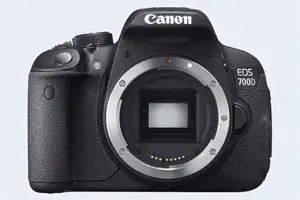Canon 700D vs M10
The Canon EOS 700D (called Canon T5i in some regions) and the Canon EOS M10 are two digital cameras that were officially introduced, respectively, in March 2013 and October 2015. The 700D is a DSLR, while the M10 is a mirrorless interchangeable lens camera. Both cameras are equipped with an APS-C sensor. Both cameras offer a resolution of 17.9 megapixels.
Below is an overview of the main specs of the two cameras as a starting point for the comparison.

Check 700D offers at
ebay.com

Check M10 offers at
ebay.com
Going beyond this snapshot of core features and characteristics, what are the differences between the Canon EOS 700D and the Canon EOS M10? Which one should you buy? Read on to find out how these two cameras compare with respect to their body size, their imaging sensors, their shooting features, their input-output connections, and their reception by expert reviewers.
Body comparison
An illustration of the physical size and weight of the Canon 700D and the Canon M10 is provided in the side-by-side display below. The two cameras are presented according to their relative size. Three consecutive perspectives from the front, the top, and the back are available. All width, height and depth dimensions are rounded to the nearest millimeter.
The M10 can be obtained in two different colors (black, white), while the 700D is only available in black.
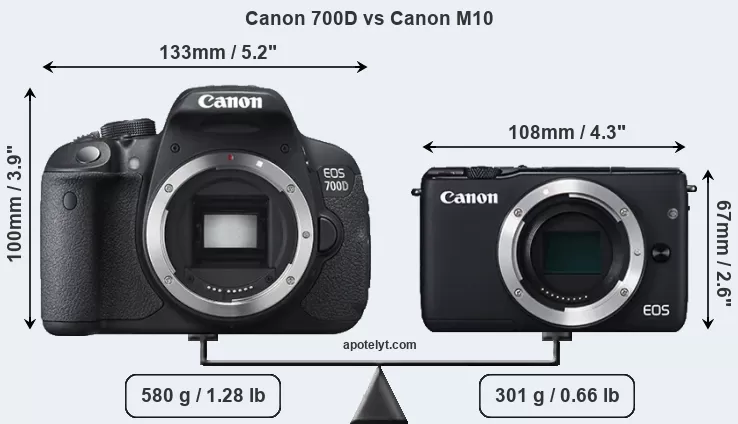
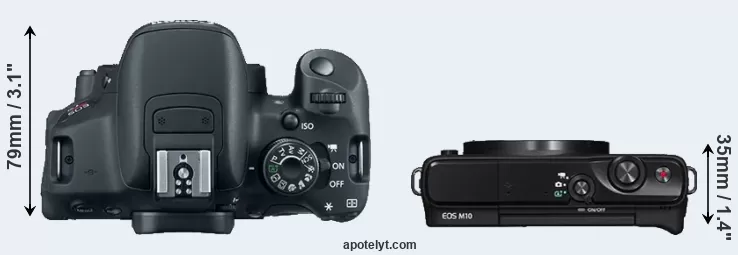
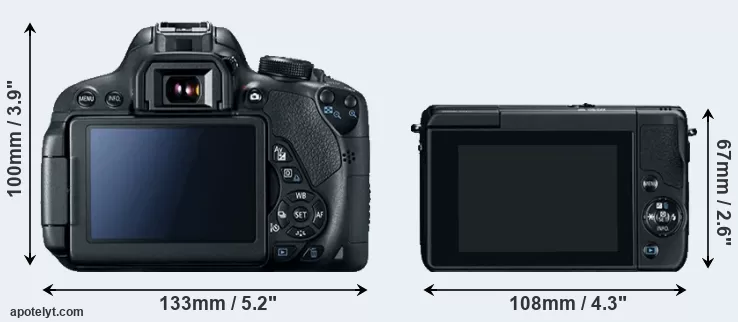
If the front view area (width x height) of the cameras is taken as an aggregate measure of their size, the Canon M10 is considerably smaller (46 percent) than the Canon 700D. Moreover, the M10 is substantially lighter (48 percent) than the 700D. In this context, it is worth noting that neither the 700D nor the M10 are weather-sealed.
The above size and weight comparisons are to some extent incomplete since they do not consider the interchangeable lenses that both of these cameras require. Hence, you might want to study and compare the specifications of available lenses in order to get the full picture of the size and weight of the two camera systems.
Concerning battery life, the 700D gets 440 shots out of its Canon LP-E8 battery, while the M10 can take 255 images on a single charge of its Canon LP-E12 power pack.
The following table provides a synthesis of the main physical specifications of the two cameras and other similar ones. In case you want to display and compare another camera duo, you can use the CAM-parator app to select your camera combination among a large number of options.

| # | Camera Model |
Camera Width |
Camera Height |
Camera Depth |
Camera Weight |
Battery Life |
Weather Sealing |
Camera Launch |
Launch Price (USD) |
Street Price |
|
|---|---|---|---|---|---|---|---|---|---|---|---|
| 1. | Canon 700D | 133 mm | 100 mm | 79 mm | 580 g | 440 | n | Mar 2013 | 649 | ebay.com | |
| 2. | Canon M10 | 108 mm | 67 mm | 35 mm | 301 g | 255 | n | Oct 2015 | 499 | ebay.com | |
| 3. | Canon M100 | 108 mm | 67 mm | 35 mm | 302 g | 295 | n | Aug 2017 | 499 | ebay.com | |
| 4. | Canon T6 | 129 mm | 101 mm | 78 mm | 485 g | 500 | n | Mar 2016 | 449 | ebay.com | |
| 5. | Canon 750D | 132 mm | 101 mm | 78 mm | 555 g | 440 | n | Feb 2015 | 749 | ebay.com | |
| 6. | Canon 760D | 132 mm | 101 mm | 78 mm | 565 g | 440 | n | Feb 2015 | 649 | ebay.com | |
| 7. | Canon M3 | 111 mm | 68 mm | 44 mm | 366 g | 250 | n | Feb 2015 | 679 | ebay.com | |
| 8. | Canon 1200D | 130 mm | 100 mm | 78 mm | 480 g | 500 | n | Feb 2014 | 449 | ebay.com | |
| 9. | Canon G7 X | 103 mm | 60 mm | 40 mm | 304 g | 210 | n | Sep 2014 | 699 | ebay.com | |
| 10. | Canon 100D | 117 mm | 91 mm | 69 mm | 407 g | 380 | n | Mar 2013 | 549 | ebay.com | |
| 11. | Canon SL1 | 117 mm | 91 mm | 69 mm | 407 g | 380 | n | Mar 2013 | 549 | ebay.com | |
| 12. | Canon 650D | 133 mm | 100 mm | 79 mm | 575 g | 440 | n | Jun 2012 | 849 | ebay.com | |
| 13. | Canon M | 109 mm | 66 mm | 32 mm | 298 g | 230 | n | Jul 2012 | 599 | ebay.com | |
| 14. | Canon 600D | 133 mm | 100 mm | 80 mm | 570 g | 440 | n | Feb 2011 | 599 | ebay.com | |
| 15. | Canon 550D | 129 mm | 98 mm | 62 mm | 530 g | 440 | n | Feb 2010 | 699 | ebay.com | |
| 16. | Canon 500D | 129 mm | 98 mm | 62 mm | 520 g | 400 | n | Mar 2009 | 799 | ebay.com | |
| Note: Measurements and pricing do not include easily detachable parts, such as add-on or interchangeable lenses or optional viewfinders. | |||||||||||
Any camera decision will obviously take relative prices into account. The retail prices at the time of the camera’s release place the model in the market relative to other models in the producer’s line-up and the competition. The M10 was launched at a somewhat lower price (by 23 percent) than the 700D, which makes it more attractive for photographers on a tight budget. Usually, retail prices stay at first close to the launch price, but after several months, discounts become available. Later in the product cycle and, in particular, when the replacement model is about to appear, further discounting and stock clearance sales often push the camera price considerably down. Then, after the new model is out, very good deals can frequently be found on the pre-owned market.
Sensor comparison
The size of the imaging sensor is a crucial determinant of image quality. A large sensor will generally have larger individual pixels that offer better low-light sensitivity, provide wider dynamic range, and have richer color-depth than smaller pixels in a sensor of the same technological generation. Furthermore, a large sensor camera will give the photographer more possibilities to use shallow depth-of-field in order to isolate a subject from the background. On the downside, larger sensors tend to be more expensive and lead to bigger and heavier cameras and lenses.
Both cameras under consideration feature an APS-C sensor and have a format factor (sometimes also referred to as "crop factor") of 1.6. Within the spectrum of camera sensors, this places the review cameras among the medium-sized sensor cameras that aim to strike a balance between image quality and portability. Both cameras have a native aspect ratio (sensor width to sensor height) of 3:2.
Technology-wise, the M10 uses a more advanced image processing engine (DIGIC 6) than the 700D (DIGIC 5), with benefits for noise reduction, color accuracy, and processing speed.
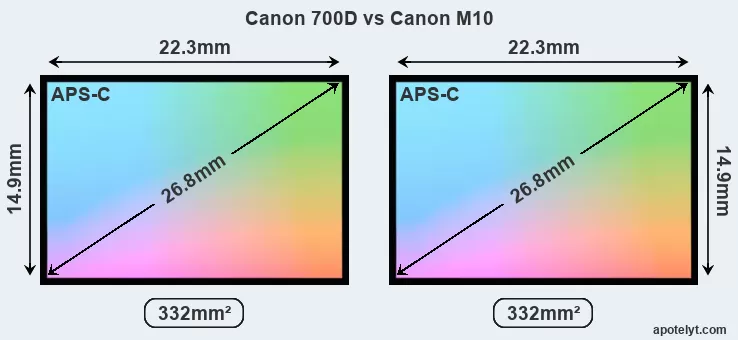
The two cameras under review do not only share the same sensor size, but also offer an identical resolution of 17.9 megapixels. This similarity in sensor specs implies that both the 700D and the M10 have the same pixel density, as well as the same pixel size. It should, however, be noted that the M10 is much more recent (by 2 years and 6 months) than the 700D, and its sensor will have benefitted from technological advances during this time.
The Canon EOS 700D has a native sensitivity range from ISO 100 to ISO 12800, which can be extended to ISO 100-25600. The Canon EOS M10 offers exactly the same ISO settings.
Technology-wise, both cameras are equipped with CMOS (Complementary Metal–Oxide–Semiconductor) sensors. Both cameras use a Bayer filter for capturing RGB colors on a square grid of photosensors. This arrangement is found in most digital cameras.
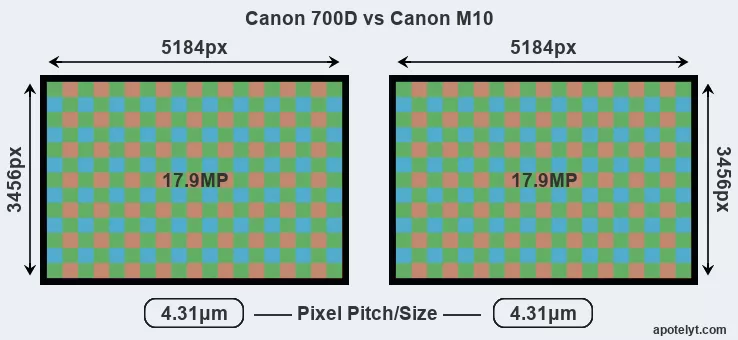
Since 2007, DXO Mark has published sensor performance measurements that have been derived using a consistent methodology. This service is based on lab testing and assigns an overall score to each camera sensor, as well as ratings for dynamic range ("DXO Landscape"), color depth ("DXO Portrait"), and low-light sensitivity ("DXO Sports"). Of the two cameras under consideration, the M10 has a markedly higher DXO score than the 700D (overall score 4 points higher), which will translate into better image quality. The advantage is based on 0.5 bits higher color depth, 0.2 EV in additional dynamic range, and 0.1 stops in additional low light sensitivity. The table below summarizes the physical sensor characteristics and sensor quality findings and compares them across a set of similar cameras.

| # | Camera Model |
Sensor Class |
Resolution (MP) |
Horiz. Pixels |
Vert. Pixels |
Video Format |
DXO Portrait |
DXO Landscape |
DXO Sports |
DXO Overall |
|
|---|---|---|---|---|---|---|---|---|---|---|---|
| 1. | Canon 700D | APS-C | 17.9 | 5184 | 3456 | 1080/30p | 21.7 | 11.2 | 681 | 61 | |
| 2. | Canon M10 | APS-C | 17.9 | 5184 | 3456 | 1080/30p | 22.2 | 11.4 | 753 | 65 | |
| 3. | Canon M100 | APS-C | 24.0 | 6000 | 4000 | 1080/60p | 23.5 | 12.9 | 1272 | 78 | |
| 4. | Canon T6 | APS-C | 17.9 | 5184 | 3456 | 1080/30p | 22.0 | 11.7 | 781 | 66 | |
| 5. | Canon 750D | APS-C | 24.0 | 6000 | 4000 | 1080/30p | 22.7 | 12.0 | 919 | 71 | |
| 6. | Canon 760D | APS-C | 24.0 | 6000 | 4000 | 1080/30p | 22.6 | 12.0 | 915 | 70 | |
| 7. | Canon M3 | APS-C | 24.0 | 6000 | 4000 | 1080/30p | 22.8 | 11.8 | 1169 | 72 | |
| 8. | Canon 1200D | APS-C | 17.9 | 5184 | 3456 | 1080/30p | 21.9 | 11.3 | 724 | 63 | |
| 9. | Canon G7 X | 1-inch | 20.0 | 5472 | 3648 | 1080/60p | 23.0 | 12.7 | 556 | 71 | |
| 10. | Canon 100D | APS-C | 17.9 | 5184 | 3456 | 1080/30p | 21.8 | 11.3 | 843 | 63 | |
| 11. | Canon SL1 | APS-C | 17.9 | 5184 | 3456 | 1080/30p | 21.8 | 11.3 | 843 | 63 | |
| 12. | Canon 650D | APS-C | 17.9 | 5184 | 3456 | 1080/30p | 21.7 | 11.2 | 722 | 62 | |
| 13. | Canon M | APS-C | 17.9 | 5184 | 3456 | 1080/30p | 22.1 | 11.2 | 827 | 65 | |
| 14. | Canon 600D | APS-C | 17.9 | 5184 | 3456 | 1080/30p | 22.1 | 11.5 | 793 | 65 | |
| 15. | Canon 550D | APS-C | 17.9 | 5184 | 3456 | 1080/30p | 22.1 | 11.5 | 784 | 66 | |
| 16. | Canon 500D | APS-C | 15.1 | 4752 | 3168 | 1080/20p | 21.7 | 11.5 | 663 | 63 |
Many modern cameras cannot only take still pictures, but also record videos. Both cameras under consideration have a sensor with sufficiently fast read-out times for moving pictures, and both provide the same movie specifications (1080/30p).
Feature comparison
Apart from body and sensor, cameras can and do differ across a range of features. For example, the 700D has an optical viewfinder, which can be very useful when shooting in bright sunlight. In contrast, the M10 relies on live view and the rear LCD for framing. The adjacent table lists some of the other core features of the Canon 700D and Canon M10 along with similar information for a selection of comparators.

| # | Camera Model |
Viewfinder (Type or 000 dots) |
Control Panel (yes/no) |
LCD Specifications (inch/000 dots) |
LCD Attach- ment |
Touch Screen (yes/no) |
Max Shutter Speed * |
Max Shutter Flaps * |
Built-in Flash (yes/no) |
Built-in Image Stab |
|
|---|---|---|---|---|---|---|---|---|---|---|---|
| 1. | Canon 700D | optical | n | 3.0 / 1040 | swivel | Y | 1/4000s | 5.0/s | Y | n | |
| 2. | Canon M10 | none | n | 3.0 / 1040 | tilting | Y | 1/4000s | 4.6/s | Y | n | |
| 3. | Canon M100 | none | n | 3.0 / 1040 | tilting | Y | 1/4000s | 6.1/s | Y | n | |
| 4. | Canon T6 | optical | n | 3.0 / 920 | fixed | n | 1/4000s | 3.0/s | Y | n | |
| 5. | Canon 750D | optical | n | 3.0 / 1040 | swivel | Y | 1/4000s | 5.0/s | Y | n | |
| 6. | Canon 760D | optical | Y | 3.0 / 1040 | swivel | Y | 1/4000s | 5.0/s | Y | n | |
| 7. | Canon M3 | optional | n | 3.0 / 1040 | tilting | Y | 1/4000s | 4.2/s | Y | n | |
| 8. | Canon 1200D | optical | n | 3.0 / 460 | fixed | n | 1/4000s | 3.0/s | Y | n | |
| 9. | Canon G7 X | none | n | 3.0 / 1040 | tilting | Y | 1/2000s | 6.5/s | Y | Y | |
| 10. | Canon 100D | optical | n | 3.0 / 1040 | fixed | Y | 1/4000s | 4.9/s | Y | n | |
| 11. | Canon SL1 | optical | n | 3.0 / 1040 | fixed | Y | 1/4000s | 4.9/s | Y | n | |
| 12. | Canon 650D | optical | n | 3.0 / 1040 | swivel | Y | 1/4000s | 5.0/s | Y | n | |
| 13. | Canon M | none | n | 3.0 / 1040 | fixed | Y | 1/4000s | 4.3/s | n | n | |
| 14. | Canon 600D | optical | n | 3.0 / 1040 | swivel | n | 1/4000s | 3.7/s | Y | n | |
| 15. | Canon 550D | optical | n | 3.0 / 1040 | fixed | n | 1/4000s | 3.7/s | Y | n | |
| 16. | Canon 500D | optical | n | 3.0 / 920 | fixed | n | 1/4000s | 3.4/s | Y | n | |
| Note: *) Information refers to the mechanical shutter, unless the camera only has an electronic one. | |||||||||||
Concerning the storage of imaging data, both the 700D and the M10 write their files to SDXC cards. Both cameras can use UHS-I cards, which provide for Ultra High Speed data transfer of up to 104 MB/s.
Connectivity comparison
For some imaging applications, the extent to which a camera can communicate with its environment can be an important aspect in the camera decision process. The table below provides an overview of the connectivity of the Canon EOS 700D and Canon EOS M10 and, in particular, the interfaces the cameras (and selected comparators) provide for accessory control and data transfer.

| # | Camera Model |
Hotshoe Port |
Internal Mic / Speaker |
Microphone Port |
Headphone Port |
HDMI Port |
USB Port |
WiFi Support |
NFC Support |
Bluetooth Support |
|
|---|---|---|---|---|---|---|---|---|---|---|---|
| 1. | Canon 700D | Y | stereo / mono | Y | - | mini | 2.0 | - | - | - | |
| 2. | Canon M10 | - | stereo / mono | - | - | mini | 2.0 | Y | Y | - | |
| 3. | Canon M100 | - | stereo / mono | - | - | micro | 2.0 | Y | Y | Y | |
| 4. | Canon T6 | Y | mono / mono | - | - | mini | 2.0 | Y | Y | - | |
| 5. | Canon 750D | Y | stereo / mono | Y | - | mini | 2.0 | Y | Y | - | |
| 6. | Canon 760D | Y | stereo / mono | Y | - | mini | 2.0 | Y | Y | - | |
| 7. | Canon M3 | Y | stereo / mono | Y | - | mini | 2.0 | Y | Y | - | |
| 8. | Canon 1200D | Y | mono / mono | - | - | mini | 2.0 | - | - | - | |
| 9. | Canon G7 X | - | stereo / mono | - | - | micro | 2.0 | Y | Y | - | |
| 10. | Canon 100D | Y | mono / mono | Y | - | mini | 2.0 | - | - | - | |
| 11. | Canon SL1 | Y | mono / mono | Y | - | mini | 2.0 | - | - | - | |
| 12. | Canon 650D | Y | stereo / mono | Y | - | mini | 2.0 | - | - | - | |
| 13. | Canon M | Y | stereo / mono | Y | - | mini | 2.0 | - | - | - | |
| 14. | Canon 600D | Y | mono / mono | Y | - | mini | 2.0 | - | - | - | |
| 15. | Canon 550D | Y | stereo / - | Y | - | mini | 2.0 | - | - | - | |
| 16. | Canon 500D | Y | mono / mono | - | - | mini | 2.0 | - | - | - |
It is notable that the 700D has a hotshoe, while the M10 does not. This socket makes it possible to easily attach optional accessories, such as an external flash gun.
Both the 700D and the M10 have been discontinued, but can regularly be found used on ebay. The 700D was replaced by the Canon 750D, while the M10 was followed by the Canon M100. Further information on the features and operation of the 700D and M10 can be found, respectively, in the Canon 700D Manual (free pdf) or the online Canon M10 Manual.
Review summary
So what is the bottom line? Which of the two cameras – the Canon 700D or the Canon M10 – has the upper hand? Is one clearly better than the other? The listing below highlights the relative strengths of the two models.
Advantages of the Canon EOS 700D:
- Better sound: Can connect to an external microphone for higher quality sound recording.
- Easier framing: Has an optical viewfinder for image composition and settings control.
- More flexible LCD: Has a swivel screen for odd-angle shots in portrait or landscape orientation.
- Longer lasting: Can take more shots (440 versus 255) on a single battery charge.
- Better lighting: Features a hotshoe and can thus hold and trigger an external flash gun.
- More heavily discounted: Has been available for much longer (launched in March 2013).
Arguments in favor of the Canon EOS M10:
- Better image quality: Scores markedly higher (4 points) in the DXO overall evaluation.
- Better jpgs: Has a more modern image processing engine (DIGIC 6 vs DIGIC 5).
- More compact: Is smaller (108x67mm vs 133x100mm) and will fit more readily into a bag.
- Less heavy: Has a lower weight (by 279g or 48 percent) and is thus easier to take along.
- More legacy lens friendly: Can use many non-native lenses via adapters.
- Easier file upload: Has wifi built in for automatic backup or image transfer to the web.
- Easier device pairing: Supports NFC for fast wireless image transfer over short distances.
- More affordable: Was released into a lower priced segment (23 percent cheaper at launch).
- More modern: Reflects 2 years and 6 months of technical progress since the 700D launch.
If the count of relative strengths (bullet points above) is taken as a measure, the M10 emerges as the winner of the match-up (9 : 6 points). However, the relevance of individual strengths will vary across photographers, so that you might want to apply your own weighing scheme to the summary points when reflecting and deciding on a new camera. A professional wedding photographer will view the differences between cameras in a way that diverges from the perspective of a travel photog, and a person interested in cityscapes has distinct needs from a macro shooter. Hence, the decision which camera is best and worth buying is often a very personal one.
How about other alternatives? Do the specifications of the Canon 700D and the Canon M10 place the cameras among the top in their class? Find out in the latest Best DSLR Camera and Best Mirrorless Interchangeable Lens Camera listings whether the two cameras rank among the cream of the crop.
In any case, while the comparison of the spec-sheets of cameras can offer a general idea of their imaging potential, it remains partial and cannot reveal, for example, the shooting experience and imaging performance when actually working with the 700D or the M10. User reviews, such as those found at amazon, can sometimes inform about these issues, but such feedback is often incomplete, inconsistent, and biased.
Expert reviews
This is where reviews by experts come in. The following table reports the overall ratings of the cameras as published by some of the major camera review sites (amateurphotographer [AP], cameralabs [CL], digitalcameraworld [DCW], dpreview [DPR], ephotozine [EPZ], photographyblog [PB]). As can be seen, the professional reviewers agree in many cases on the quality of different cameras, but sometimes their assessments diverge, reinforcing the earlier point that a camera decision is often a very personal choice.

| # | Camera Model |
AP score |
CL score |
DCW score |
DPR score |
EPZ score |
PB score |
Camera Launch |
Launch Price (USD) |
Street Price |
|
|---|---|---|---|---|---|---|---|---|---|---|---|
| 1. | Canon 700D | .. | .. | .. | 76/100 | 4.5/5 | 4.5/5 | Mar 2013 | 649 | ebay.com | |
| 2. | Canon M10 | .. | .. | .. | .. | .. | 4/5 | Oct 2015 | 499 | ebay.com | |
| 3. | Canon M100 | 3/5 | + | .. | .. | 4/5 | 3.5/5 | Aug 2017 | 499 | ebay.com | |
| 4. | Canon T6 | 4/5 | o | 4/5 | 73/100 | 4/5 | 4/5 | Mar 2016 | 449 | ebay.com | |
| 5. | Canon 750D | 5/5 | .. | .. | 75/100 | 4.5/5 | 4.5/5 | Feb 2015 | 749 | ebay.com | |
| 6. | Canon 760D | 5/5 | + | .. | 77/100 | 4.5/5 | 4.5/5 | Feb 2015 | 649 | ebay.com | |
| 7. | Canon M3 | 4/5 | o | .. | 75/100 | 4.5/5 | 4/5 | Feb 2015 | 679 | ebay.com | |
| 8. | Canon 1200D | 3/5 | + | .. | .. | 4/5 | 4.5/5 | Feb 2014 | 449 | ebay.com | |
| 9. | Canon G7 X | 4/5 | + + | .. | 77/100 | 4.5/5 | 4.5/5 | Sep 2014 | 699 | ebay.com | |
| 10. | Canon 100D | 4/5 | + | .. | 78/100 | 4/5 | 4/5 | Mar 2013 | 549 | ebay.com | |
| 11. | Canon SL1 | 4/5 | + | .. | 78/100 | 4/5 | 4/5 | Mar 2013 | 549 | ebay.com | |
| 12. | Canon 650D | 4/5 | + + | .. | 77/100 | 4.5/5 | 4.5/5 | Jun 2012 | 849 | ebay.com | |
| 13. | Canon M | 3/5 | + | .. | .. | 4/5 | 4/5 | Jul 2012 | 599 | ebay.com | |
| 14. | Canon 600D | 3/5 | o | .. | 77/100 | 4.5/5 | 4.5/5 | Feb 2011 | 599 | ebay.com | |
| 15. | Canon 550D | .. | + + | .. | 77/100 | 4/5 | 4.5/5 | Feb 2010 | 699 | ebay.com | |
| 16. | Canon 500D | .. | + + | .. | 74/100 | 4.5/5 | 4.5/5 | Mar 2009 | 799 | ebay.com | |
| Note: (+ +) highly recommended; (+) recommended; (o) reviewed; (..) not available. | |||||||||||
The above review scores should be interpreted with care, though. The assessments were made in relation to similar cameras of the same technological generation. Hence, a score should always be seen in the context of the camera's market launch date and its price, and rating-comparisons among cameras that span long time periods or concern very differently equipped models make little sense. Also, please note that some of the review sites have changed their methodology and reporting over time.

Check 700D offers at
ebay.com

Check M10 offers at
ebay.com
Other camera comparisons
Did this review help to inform your camera decision process? If you would like to see a different side-by-side camera review, just use the search menu below. Alternatively, you can follow any of the listed hyperlinks for comparisons that others found interesting.
- Canon 700D vs Canon M200
- Canon 700D vs Fujifilm X-T100
- Canon 700D vs Olympus E-300
- Canon 700D vs Olympus E-P1
- Canon 700D vs Panasonic G2
- Canon 700D vs Sony NEX-5R
- Canon M10 vs Canon S120
- Canon M10 vs Canon T7i
- Canon M10 vs Leica D-LUX 5
- Canon M10 vs Nikon D3S
- Canon M10 vs Nikon D800E
- Canon M10 vs Sony RX100 II
Specifications: Canon 700D vs Canon M10
Below is a side-by-side comparison of the specs of the two cameras to facilitate a quick review of their differences and common features.
| Camera Model | Canon 700D | Canon M10 |
|---|---|---|
| Camera Type | Digital single lens reflex | Mirrorless system camera |
| Camera Lens | Canon EF mount lenses | Canon EF-M mount lenses |
| Launch Date | March 2013 | October 2015 |
| Launch Price | USD 649 | USD 499 |
| Sensor Specs | Canon 700D | Canon M10 |
| Sensor Technology | CMOS | CMOS |
| Sensor Format | APS-C Sensor | APS-C Sensor |
| Sensor Size | 22.3 x 14.9 mm | 22.3 x 14.9 mm |
| Sensor Area | 332.27 mm2 | 332.27 mm2 |
| Sensor Diagonal | 26.8 mm | 26.8 mm |
| Crop Factor | 1.6x | 1.6x |
| Sensor Resolution | 17.9 Megapixels | 17.9 Megapixels |
| Image Resolution | 5184 x 3456 pixels | 5184 x 3456 pixels |
| Pixel Pitch | 4.31 μm | 4.31 μm |
| Pixel Density | 5.39 MP/cm2 | 5.39 MP/cm2 |
| Moiré control | Anti-Alias filter | Anti-Alias filter |
| Movie Capability | 1080/30p Video | 1080/30p Video |
| ISO Setting | 100 - 12,800 ISO | 100 - 12,800 ISO |
| ISO Boost | 100 - 25,600 ISO | 100 - 25,600 ISO |
| Image Processor | DIGIC 5 | DIGIC 6 |
| DXO Sensor Quality (score) | 61 | 65 |
| DXO Color Depth (bits) | 21.7 | 22.2 |
| DXO Dynamic Range (EV) | 11.2 | 11.4 |
| DXO Low Light (ISO) | 681 | 753 |
| Screen Specs | Canon 700D | Canon M10 |
| Viewfinder Type | Optical viewfinder | no viewfinder |
| Viewfinder Field of View | 95% | |
| Viewfinder Magnification | 0.53x | |
| LCD Framing | Live View | Live View |
| Rear LCD Size | 3.0inch | 3.0inch |
| LCD Resolution | 1040k dots | 1040k dots |
| LCD Attachment | Swivel screen | Tilting screen |
| Touch Input | Touchscreen | Touchscreen |
| Shooting Specs | Canon 700D | Canon M10 |
| Focus System | Phase-detect AF | On-Sensor Phase-detect |
| Continuous Shooting | 5 shutter flaps/s | 4.6 shutter flaps/s |
| Shutter Life Expectancy | 100 000 actuations | 100 000 actuations |
| Fill Flash | Built-in Flash | Built-in Flash |
| Storage Medium | SDXC cards | SDXC cards |
| Single or Dual Card Slots | Single card slot | Single card slot |
| UHS card support | UHS-I | UHS-I |
| Connectivity Specs | Canon 700D | Canon M10 |
| External Flash | Hotshoe | no Hotshoe |
| USB Connector | USB 2.0 | USB 2.0 |
| HDMI Port | mini HDMI | mini HDMI |
| Microphone Port | External MIC port | no MIC socket |
| Wifi Support | no Wifi | Wifi built-in |
| Near-Field Communication | no NFC | NFC built-in |
| Body Specs | Canon 700D | Canon M10 |
| Battery Type | Canon LP-E8 | Canon LP-E12 |
| Battery Life (CIPA) | 440 shots per charge | 255 shots per charge |
| Body Dimensions |
133 x 100 x 79 mm (5.2 x 3.9 x 3.1 in) |
108 x 67 x 35 mm (4.3 x 2.6 x 1.4 in) |
| Camera Weight | 580 g (20.5 oz) | 301 g (10.6 oz) |

Check 700D offers at
ebay.com

Check M10 offers at
ebay.com
Did you notice an error on this page? If so, please get in touch, so that we can correct the information.
